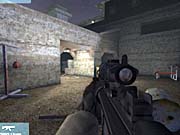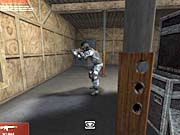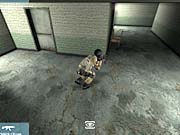Tom Clancy's Rainbow Six: Raven Shield Updated Preview
A face-lift was the goal for this next game in the Rainbow Six tactical action series, and now it's apparent that multiplayer wasn't forgotten.
Tom Clancy's Rainbow Six: Raven Shield is taking the Rainbow Six series of tactical action games in new directions, including with multiplayer. Though the focus, as always, is on the realistic squad-based combat made so popular by the original Rainbow Six, Raven Shield aims to give the series a face-lift. Not only does the game use the latest Unreal engine, but it also includes many new features and noticeable advancements in areas such as team and enemy AI, control, ease of use, and multiplayer gaming. The multiplayer component of Raven Shield specifically has been given much attention since we last saw the game.

Raven Shield multiplayer is broken into a number of adversarial and cooperative game modes. Adversarial modes have players competing against each other, while the cooperative modes have players working together to complete objectives. On the adversarial side, survival and team survival modes are much like traditional deathmatch. Three other adversarial modes (bomb, hostage, and pilot) and three cooperative modes (mission, terrorist hunt, and hostage rescue) are also included.
The Rainbow Six series has traditionally been difficult to pick up and play, with a steep learning curve for those unfamiliar with the series and a level of complexity that has driven many gamers away. Raven Shield's multiplayer mode, however, attains a remarkable level of user-friendliness, probably thanks in large part to its instant familiarity to players of such games as Counter-Strike. Essentially, the multiplayer mechanics are very similar to those of Counter-Strike--there are rounds with a set duration, and once you are killed in a certain round, you must sit out until the next round begins. Like team survival, which most directly parallels Counter-Strike, many modes are structurally very similar to familiar games.
Though the multiplayer mode uses some now-familiar game mechanics, the gameplay itself seems in fact very different, and many of the new advancements introduced for single-player Raven Shield are just as prevalent in multiplayer. The ability to open doors at variable speeds by scrolling the mouse wheel is just as helpful in multiplayer as in single-player--you can now peek through a door or use it as cover against enemies. Similarly, being able to slide down ladders proves strategically invaluable, as do other innovations, like damage mapping, which results in players with leg injuries being unable to run.

Many other signature Rainbow Six elements aim to keep the multiplayer experience distinct from similar games. You are given 20 seconds to pick equipment before the map begins. In traditional Rainbow Six style, the options are exhaustive, but it's now easy to choose your equipment and quickly learn about it. For example, when a particular weapon is selected, the weapon's attributes (range, damage, accuracy, stability, and recovery) are depicted on a comparative scale, ranging from 1 to 100. At a glance, it is easy to see the gun's strengths and weaknesses and to find the right gun for what you plan to do. All guns seen in previous Rainbow Six games should be available, and weaponry ranging from rifles and machine guns to pistols is available for use. In addition to the primary and secondary weaponry, other classic Rainbow Six equipment, like various grenades, can also be used in multiplayer. As a welcome addition, after you have been killed in a round and are awaiting the next, you are free to peruse the equipment and make your selections. The selected equipment becomes the default for each subsequent round.
The new graphics power hinted at with the jump to the latest Unreal engine appears to be in full effect. As seen recently in Unreal Tournament 2003, the engine is capable of a whole lot, and many of the same features translate to Raven Shield--notably the character detail and animations. The rag-doll physics model that allows bodies and objects to realistically fall down stairs, fold into corners, and impact with other objects appears as strong in Raven Shield and produces breathtaking death animations. Though there's no telling what the characters may be seen doing, it is always interesting to watch bodies fall off ledges, fall against walls and crumple, and otherwise look extremely real in unique ways. The characters themselves are so detailed that you can make out each piece of equipment, and they have fluid normal animations for such actions as walking, running, or firing.
Some unique and interesting new effects are also included. Tear gas grenades, for instance, blur vision in a remarkable manner. Furthermore, fragmentation grenades can go so far as to destroy doors, shattering the wood in a small explosion. Also, when a flashbang catches you in its blast, the current screen freezes and remains in the foreground while the real view slowly blends back in as the effect subsides. The overall effect is something like double vision, as for a time, you see a single snapshot that slowly fades away on top of the normal view. Accompanying the visual effect is a high-pitch sound that subsides in unison with its visual counterpart, both mimicking real flashbang effects.

Raven Shield multiplayer may seem like the next evolution of Counter-Strike, but that might not really be a bad thing. Having hallmark Rainbow Six realism features--like variable weapon accuracy represented with the signature expanding crosshairs and the ability to lean and go prone--injected into a now-familiar model would alone likely create a unique experience while accomplishing the goal of familiarity. But Raven Shield also includes a myriad of improvements to its single-player game, which amounts to a sizable addition. We documented many of the game's general and single-player innovations when we last previewed the game, which you can find
Raven Shield unfortunately has now been delayed to February, but you won't need to wait until then to get a taste of many of these multiplayer features. Publisher Ubi Soft has released a multiplayer demo, which is available now, and in it you can play two maps and as many game modes.
Got a news tip or want to contact us directly? Email news@gamespot.com
Join the conversation